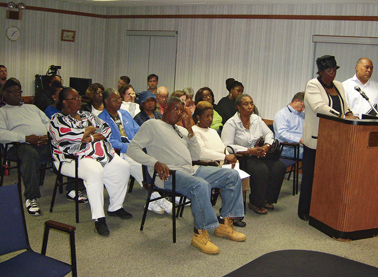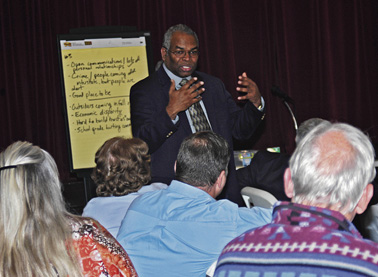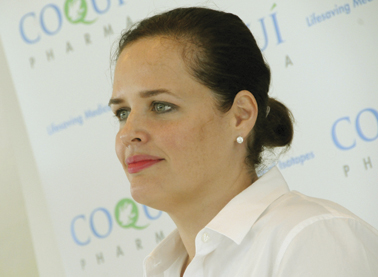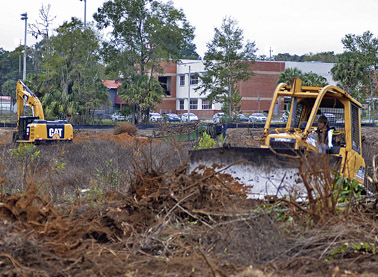SOCIAL MEDIA AT CENTER OF CONTROVERSY

Evelyn Foxx, President, Alachua County Branch of NAACP (at podiuim) cals for the firing of Assistant City Manager of Archer, John Mayberr.
ARCHER – A relatively short agenda for Archer's first city commission meeting of 2015 ended up in a 2 1/2-hour. battle to get to and stay on agenda items. At every juncture, citizens brought up issues relating to firing the assistant city manager or questions as to the exact city process that had been used to make commission or city government decisions. In particular, realtor Laurie Costello stood up on each issue to condemn the city for their actions, which she characterized as irresponsible, not proper procedure, not transparent or just plain wrong.
The focus of much of the meeting surrounded comments made by Evelyn Foxx, President, Alachua County Branch of NAACP. Foxx addressed commissioners early in the evening to further her request for the City to fire Assistant City Manager John Mayberry for comments she deemed “racist” on Mayberry's personal social media site.
Foxx had made her initial request at the last commission meeting in 2014 and was back to see what the commission had decided.
She indicated that although she knew only the city manager could actually fire Mayberry, she also knew that City Manager Grieshaber served at the pleasure of the commission. She was hopeful that commissioners had directed Grieshaber to fire Mayberry. In addition, Foxx requested Mayberry publicly apologize to the citizens of Archer and remove the comments on his social media page.
Since Mayberry was sitting directly behind the podium as she spoke, it was clear he had not been fired, which dismayed Foxx and many of the citizens who were seated and overflowed into the commission lobby listening to the proceedings.
The large crowd appeared due to Foxx's invitation to a “mass meeting” of 50-60 people earlier in the evening at a local church. She confirmed later that many residents of Holly Hill subdivision showed up to that meeting. Several members of the press had also been invited. Approximately 15 minutes before the commission meeting was to begin, the group followed Foxx to City Hall.
The City was prepared with a statement after listening to Foxx's second request to dismiss Mayberry.
“The City of Archer stands with the NAACP to ensure political educational, social and economic equality of rights of all persons and to eliminate race-based discrimination. Likewise, Archer stands with the NAACP to educate persons as to their constitutional rights and to take all lawful action to secure and allow the exercise of them.
“In the U.S. where we have the first amendment, the remedy for speech with which we disagree or find offensive is not censorship. The remedy instead is counter speech to add more speech to the marketplace of ideas. There is no democracy without words printed or uttered. Silence is the end of freedom.
“The U.S. Supreme Court noted that 'the fact that the society might find speech offensive is not a sufficient reason for suppressing it. Indeed, if it is the speaker’s opinion that gives offense, that consequence is a reason for according it constitutional protection.'”
City Attorney Scott Walker also was prepared with several cases indicating decisions that had been made by the courts in similar circumstances which supported Mayberry's right to free speech when he was expressing his personal opinion separate from the city government.
Foxx said she understood Mayberry had not broken any laws, but felt that Mayberry's social media comments showed his true feelings about African-Americans and others and may be responsible for why the residents of Holly Hills felt they were being neglected by the city. Foxx said later the Holly Hills residents commented to her that in earlier times, their part of town was not neglected, but that had now changed.
When asked why she did not accept the invitations by the City to sit down and talk about this after it was brought up at the 2014 meeting, she responded, “This is not 1963 where white men call in a few blacks behind closed doors and discuss things. Things need to be transparent. What are you going to talk about behind closed doors that you can't discuss in public?”
In a later interview, Foxx also pointed to comments made by Commissioner Fletcher Hope indicating he had not seen the City's statement until just before the meeting and he felt the comments reflected the opinion of Mayor Frank Ogdon. He said he personally agreed with the first paragraph of the statement, but not the rest.
Foxx said that statement by Commissioner Hope indicated to her there had been a meeting “out of the sunshine” if everyone else knew about the statement except Commissioner Hope.
Hearing that the city was not planning to fire Mayberry, Foxx left the podium indicating that the full force of the NAACP would be focused on the City of Archer. “We don't want to have another Ferguson,” she said. Later she said, “Commissioners are angry. Citizens are angry. When both sides are as angry as they are, there's no telling what might happen.”
In a later interview, Ogdon said, “I'm saddened by the statement by Ms. Foxx that we are going to have another Ferguson on our hands in Archer. Are we to expect violent unrest, looting, burning and total mayhem because we live in a city, state and country that protects Mr. Mayberry's right to free speech? Ms. Foxx said she realized Mr. Mayberry's action were not illegal, but she thought we should fire him anyway because his freedom of speech offended her and some others. I am sorry people are offended by Mr. Mayberry, but I am offended Ms. Foxx would threaten the City with another Ferguson-type response. I am also sorry Ms. Foxx did not choose to meet with city officials to help resolve this issue earlier, as the City requested, rather than further divide our community by her threats.”
In a subsequent interview, Foxx indicated she would have to talk to the NAACP's state conference president as to how to proceed. “If we have to do something drastic, it will be through the national organization. I am not going to stop just because they [the city] want[s] me to,” she said.
Foxx said a rally would be held on Monday, Jan. 19, at around 2 or 3 p.m., which will include a voter registration drive. “The only way that things change is through the ballot box,” she said. She said their focus would probably be on unregistered voters in the Holly Hills neighborhood, but details had not been worked out yet.
“The controversy that has been brought to our attention stems from postings, albeit insensitive to one or another, were expressions by an individual as are opinions of others that the postings were offensive,” commented Grieshaber. “Free speech is about fair debate and comment. It is not about censorship.”
He also confirmed that he and the city attorney are in the process of crafting a policy to address social media. Once it has been completed, it will be put before the commission for a vote. If it is approved, it will be added to the City of Archer Personnel Policy and Employee Handbook.
# # #
Email cwalker@
alachuatoday.com
 Alachua County Superintendent of Schools Owen Roberts responds to community members attending the Alachua school forum and explains his vision of achieving excellence in education
Alachua County Superintendent of Schools Owen Roberts responds to community members attending the Alachua school forum and explains his vision of achieving excellence in education


 A much anticipated Publix supermarket slated for Alachua appears to be underway as site preparation has begun on the property located along U.S. Highway 441 and adjacent to Santa Fe High School in Alachua. Land clearing crews were at work on the property where the proposed Publix is to occupy 46,031 square feet of a 56,431 building. It is expected that another 10,400 square feet will be divided among eight retail bays. Michael Ryals of Bosshardt Realty confirmed that the developer has closed on the real estate, and that they have commitments on roughly three quarters of the retail spaces. Among the shops planned for the space is a restaurant, salon services, nail services and a liquor store. On Nov. 18, the City of Alachua’s Planning and Zoning board gave the nod to a site plan presented by developers of the property. Ryals said actual construction could begin as earlier as this month or next.
A much anticipated Publix supermarket slated for Alachua appears to be underway as site preparation has begun on the property located along U.S. Highway 441 and adjacent to Santa Fe High School in Alachua. Land clearing crews were at work on the property where the proposed Publix is to occupy 46,031 square feet of a 56,431 building. It is expected that another 10,400 square feet will be divided among eight retail bays. Michael Ryals of Bosshardt Realty confirmed that the developer has closed on the real estate, and that they have commitments on roughly three quarters of the retail spaces. Among the shops planned for the space is a restaurant, salon services, nail services and a liquor store. On Nov. 18, the City of Alachua’s Planning and Zoning board gave the nod to a site plan presented by developers of the property. Ryals said actual construction could begin as earlier as this month or next. HIGH SPRINGS – A stolen Chevy Trailblazer and a car load of food, electronics and fire arms, which had been purchased using stolen credit cards, were recovered by the High Springs Police Department (HSPD) following a traffic stop on Jan. 6.
HIGH SPRINGS – A stolen Chevy Trailblazer and a car load of food, electronics and fire arms, which had been purchased using stolen credit cards, were recovered by the High Springs Police Department (HSPD) following a traffic stop on Jan. 6. 
 ALACHUA – The annual Cleather Hathcock Community Center Senior Fashion Show was held Saturday, Dec. 13 at 5 p.m. at Mebane Middle School Auditorium. Wal-Mart Distribution Center and the City of Alachua donated Christmas gifts to give out to seniors, children and other members of the audience.
ALACHUA – The annual Cleather Hathcock Community Center Senior Fashion Show was held Saturday, Dec. 13 at 5 p.m. at Mebane Middle School Auditorium. Wal-Mart Distribution Center and the City of Alachua donated Christmas gifts to give out to seniors, children and other members of the audience.